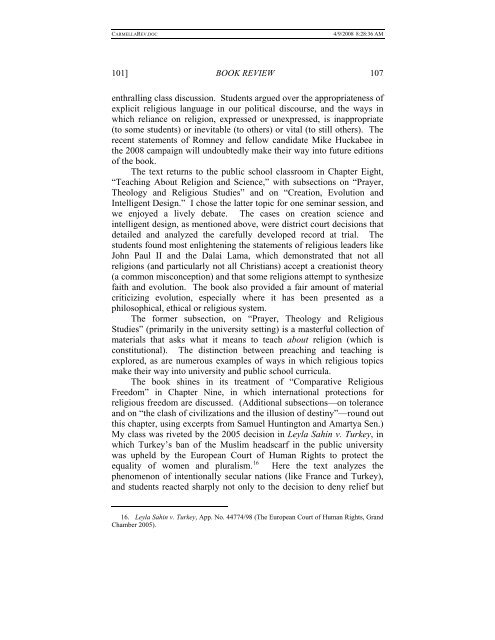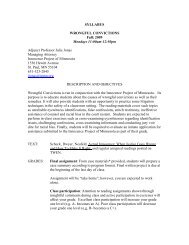LAW AND RELIGION: CASES AND MATERIALS - Hamline Law
LAW AND RELIGION: CASES AND MATERIALS - Hamline Law
LAW AND RELIGION: CASES AND MATERIALS - Hamline Law
You also want an ePaper? Increase the reach of your titles
YUMPU automatically turns print PDFs into web optimized ePapers that Google loves.
CARMELLAREV.DOC 4/9/2008 8:28:36 AM<br />
101] BOOK REVIEW 107<br />
enthralling class discussion. Students argued over the appropriateness of<br />
explicit religious language in our political discourse, and the ways in<br />
which reliance on religion, expressed or unexpressed, is inappropriate<br />
(to some students) or inevitable (to others) or vital (to still others). The<br />
recent statements of Romney and fellow candidate Mike Huckabee in<br />
the 2008 campaign will undoubtedly make their way into future editions<br />
of the book.<br />
The text returns to the public school classroom in Chapter Eight,<br />
“Teaching About Religion and Science,” with subsections on “Prayer,<br />
Theology and Religious Studies” and on “Creation, Evolution and<br />
Intelligent Design.” I chose the latter topic for one seminar session, and<br />
we enjoyed a lively debate. The cases on creation science and<br />
intelligent design, as mentioned above, were district court decisions that<br />
detailed and analyzed the carefully developed record at trial. The<br />
students found most enlightening the statements of religious leaders like<br />
John Paul II and the Dalai Lama, which demonstrated that not all<br />
religions (and particularly not all Christians) accept a creationist theory<br />
(a common misconception) and that some religions attempt to synthesize<br />
faith and evolution. The book also provided a fair amount of material<br />
criticizing evolution, especially where it has been presented as a<br />
philosophical, ethical or religious system.<br />
The former subsection, on “Prayer, Theology and Religious<br />
Studies” (primarily in the university setting) is a masterful collection of<br />
materials that asks what it means to teach about religion (which is<br />
constitutional). The distinction between preaching and teaching is<br />
explored, as are numerous examples of ways in which religious topics<br />
make their way into university and public school curricula.<br />
The book shines in its treatment of “Comparative Religious<br />
Freedom” in Chapter Nine, in which international protections for<br />
religious freedom are discussed. (Additional subsections—on tolerance<br />
and on “the clash of civilizations and the illusion of destiny”—round out<br />
this chapter, using excerpts from Samuel Huntington and Amartya Sen.)<br />
My class was riveted by the 2005 decision in Leyla Sahin v. Turkey, in<br />
which Turkey’s ban of the Muslim headscarf in the public university<br />
was upheld by the European Court of Human Rights to protect the<br />
equality of women and pluralism. 16 Here the text analyzes the<br />
phenomenon of intentionally secular nations (like France and Turkey),<br />
and students reacted sharply not only to the decision to deny relief but<br />
16. Leyla Sahin v. Turkey, App. No. 44774/98 (The European Court of Human Rights, Grand<br />
Chamber 2005).
















